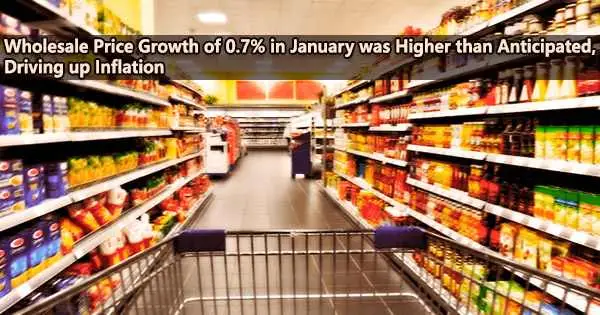According to a report released on Thursday by the Labor Department, producer prices increased more than anticipated to start the year, which caused wholesale inflation to pick up in January.
The producer price index, which tracks how much raw materials sell for on the open market, increased by 0.7% in month, the most since June. Following a decline of 0.2% in December, economists surveyed by Dow Jones had anticipated an increase of 0.4%.
In contrast to estimates for a 0.3% increase, the core PPI grew by 0.5% when food and energy were excluded. Core excluding trade services climbed 0.6%, against the estimate for a 0.2% rise.
On a 12-month basis, headline PPI increased 6%, still elevated but well off its 11.6% peak in March 2022.
Following the news, markets dropped, with futures for the Dow Jones Industrial Average dropping by approximately 200 points.
The PPI reflects the first price manufacturers get on the open market, thus even while it isn’t as regularly monitored as some other inflation indices, it can still be a leading indication.
The consumer pricing index for January, which calculates how much consumers pay for goods and services, increased by 0.5% at the same time as the PPI increased. Combined, the metrics reveal that while inflation seemed to be slowing down as 2022 came to a conclusion, it actually picked up steam at the beginning of 2023.
Economists to a few seasonal factors as well as payback from months that had more subdued price increases are mostly attributing the January inflation surge. A part may have also been played by the exceptionally warm winter and the month-to-month increase in gasoline prices, which are prone to volatility.
My expectation is that we will see a meaningful improvement in inflation this year and further improvement over the following year, with inflation reaching our 2% goal in 2025. But my outlook is contingent on appropriate monetary policy.
Cleveland Fed
A report Wednesday showed that consumer spending more than kept pace with inflation, as retail sales increased 3% for the month and were up 6.4% from a year ago.
In other economic data Thursday, the Labor Department reported that jobless claims edged lower to 194,000, a decline of 1,000 and below the Dow Jones estimate for 200,000. Also, the Philadelphia Federal Reserve’s manufacturing index for February plunged to -24.3, well below the -7.8 estimate.
The January data are unlikely to deter Fed policymakers from their position that, while progress is being made, no letup is likely because they are concentrating heavily on inflation.
“My expectation is that we will see a meaningful improvement in inflation this year and further improvement over the following year, with inflation reaching our 2% goal in 2025,” Cleveland Fed President Loretta Mester said in a speech Thursday morning. “But my outlook is contingent on appropriate monetary policy.”
Markets expect the Fed to increase interest rates a few more times this year, according to CME Group data, with the final, or “terminal,” rate ending around a range of 5.25%-5.5%, from its current 4.5%-4.75%.
The higher PPI reading came amid a 5% rise in energy costs but a 1% decline in food. The final demand index for goods climbed 1.2%, the biggest one-month increase since June. About one-third of that rise came from the gasoline index gaining 6.2%.
The price of final demand services, excluding commerce, transportation, and warehousing, increased by 0.6%, contributing to a 0.4% increase in the services index. A 1.4% increase in the index for hospital outpatient care was a significant additional contributing element.
















